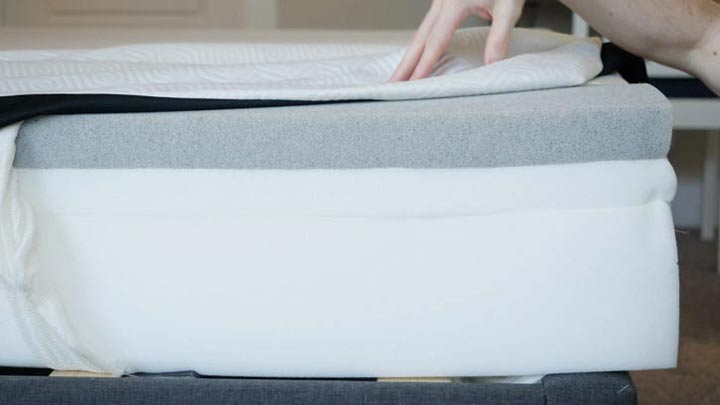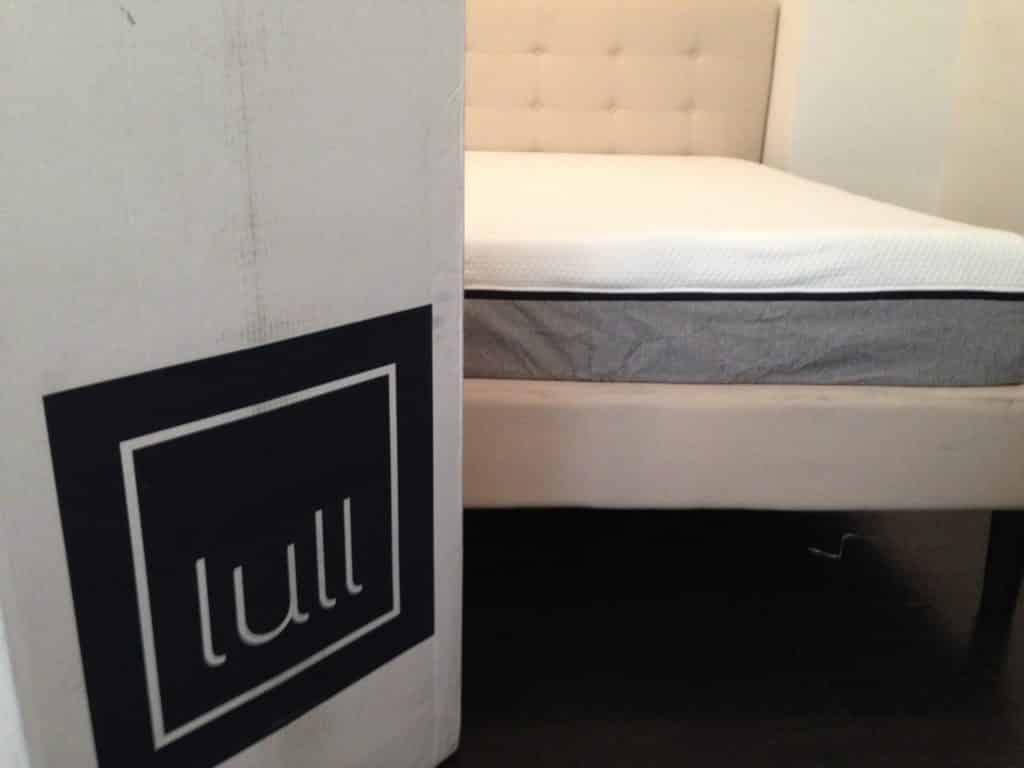Memory foam mattresses are popular because they cushion joints and support the spine. Many people love the slow-moving feel, but some people fear that memory foam is harmful to their health.
So, is memory foam toxic? The answer isn’t always cut and dried. Some memory foam mattresses contain harmful chemicals, but there are many non-toxic options on the market. I’ve examined the research so that you can find a memory foam mattress that works for your needs.
What is Memory Foam?
Memory foam was invented when NASA-funded researchers sought new ways to improve comfort, protection, and shock absorption for test pilots in the 1960s. This plush material, made from polyurethane foam, has rocketed out of the lab and into our daily lives. You’ll find memory foam inside football helmets, shoe insoles, airline seats, and, of course, mattresses.

What is Memory Foam Made Out of?
Polyurethane foam, or memory foam, is a porous synthetic material with a cellular structure. Polyurethane foams are made of various chemical components such as:
- Polyols – an organic macromolecule made from natural or crude oils
- Diisocyanates – chemical building blocks used to make the foam more rigid and flexible
- Blowing agents – gas that blows little pockets of air (cells) into the polyurethane to create the foam structure
- Additives – surfactants, catalysts, fillers, and curatives can be added during the manufacturing process to speed the process, change the weight of the foam, reduce flammability, and customize the foam.
Is Memory Foam Safe?
Polyurethane foam is generally considered safe. However, memory foam is made from petrochemicals that emit volatile organic compounds (VOCs), which can pollute the air inside your home and bring potential health risks. Many VOCs are human-made chemicals used in the manufacturing of household products, including paints, pesticides, cleaning supplies, building materials, and furnishings.

Generally, there are more VOCs indoors than outdoors, according to the United States Environmental Protection Agency (EPA). VOCs can pose both short-term and long-term health effects.
The American Lung Association warns that breathing VOCs can irritate the eyes, nose, and throat. They also emphasize that VOCs can damage the central nervous system and other organs.
Potentially Hazardous Chemicals Found Inside Memory Foam
Memory foam mattresses contain small amounts of potentially hazardous chemicals. A chemical’s toxicity is typically dependent on the dose and duration of exposure.
The health risks outlined below are more relevant to workers in industrial settings than consumers. Even so, some people are more at risk than others and may want to avoid exposure to the following chemicals that may be found inside memory foam mattresses:
Methylbenzene, also known as toluene, poses a few health risks. According to the Centers for Disease Control and Prevention (CDC), toluene exposure can cause, “eye and nose irritation, tiredness, confusion, dizziness, headache, dilated pupils, nerve damage, inflammation of the skin, and liver and kidney damage.” It’s important to remember that people who constantly work with this chemical, such as construction workers and nail technicians, are most at risk of developing adverse reactions.
Acetone poses some short-term risks when inhaled frequently. These risks include: irritation of the eyes, nose, throat, trachea, and lungs. Acetone can also cause joint, bone, and muscular pain, as well as pregnancy complications.
Formaldehyde, with frequent exposure, can irritate the skin, throat, lungs, and eyes. Repeated exposure to formaldehyde may be linked to cancer.
Does Memory Foam Contain Fiberglass?
Fiberglass is often used as a cost-effective flame retardant, and some mattress manufacturers may use it to meet fire safety standards. If fiberglass is present, you may see it listed on a mattress label as “glass fiber” or “glass wool.”
Fiberglass is made of silica sand, limestone, recycled glass, and soda ash. It can be irritating to the eyes, skin, and lungs. Long-term exposure has been linked to lung disease.
To avoid fiberglass exposure, make sure to keep the mattress’s protective covers and fire barriers in place. You can also look at our list of the best mattresses without fiberglass.
Flame Retardants in Mattresses
U.S. Consumer Product Safety Commission (CPSC) requirements state that all mattresses must contain flame retardants to withstand exposure to an open flame for a sustained period.
Mattress flame retardants often contain chemicals with known health risks, including:
- immune system damage
- endocrine and thyroid function damage
- reproductive toxicity
- impaired neurological function
- cancer
Unfortunately, memory foam mattresses are extremely flammable, so manufacturers use more powerful chemical flame retardants to help them meet safety standards for flammability.
Memory Foam Off-Gassing
When you unbox a new memory foam mattress, VOCs from the manufacturing process are released into the air. We call this “off-gassing,” and it often results in a faint chemical smell.

Though this may sound concerning, there is no evidence that these chemicals post health risks. It’s also important to remember that many household products emit VOCs, from paint to building materials, furnishings, and even cleaning products.
It often takes about two days for a bed-in-a-box mattress to fully off-gas and expand. Here are a few ways you can speed up the off-gassing process:
- Give your mattress time to air out before you move it into your home. Unbox or unwrap it outside and let it breathe for two days.
- Ventilate your home after your new mattress is in place. Open your windows and use an air filter with activated carbon filtration designed to remove chemicals and VOCs from the air.
What are the Best Non-Toxic Memory Foam Mattresses?
Low-quality foam mattresses are more likely to contain cheap materials with higher levels of toxic chemicals. High-quality memory foam mattresses, such as Nectar and Saatva, contain eco-friendly materials that don’t emit as many harmful chemicals. Take a look at our list of the best memory foam mattresses for some more non-toxic options.

Look for Mattress Certifications
Many mattress companies go the extra mile to ensure their products are non-toxic and eco-friendly. Here are a few mattress certifications to look for when shopping for a non-toxic memory foam bed.
CertiPUR-US®
If a mattress is CertiPUR-US® certified, it is free from harmful materials and chemicals such as formaldehyde, mercury, and lead. These mattresses also have low VOC emissions.
OEKO-TEX®
The OEKO-TEX® certification ensures that the mattress has undergone rigorous testing from top to bottom. If you see this seal, you can rest assured that your mattress is free from toxic and harmful materials.
GREENGUARD GOLD
Mattresses with GREENGUARD GOLD certifications have low VOC emissions. Most of the time, this certification is awarded to latex mattresses. But you can occasionally find memory foam mattresses with this seal as well, such as the PlushBeds Cooling Gel mattress.
FAQs
How long does memory foam take to off-gas?
Memory foam mattresses typically take two days to off-gas. You can speed up the process by placing the mattress in a well-ventilated room near several fans.
What are the disadvantages of memory foam?
Memory foam is a synthetic material made from chemicals that can off-gas VOCs, which could be a disadvantage to people with certain health problems. Memory foam also tends to trap body heat.
Are memory foam mattresses good or bad for your back?
Memory foam mattresses can be good options for people with back pain, but it’s important to find the right one. For example, heavier back sleepers may need a firm memory foam mattress, while lightweight side sleepers may need a softer one. Take a look at our list of the best mattresses for back pain to find one that could work for you.

